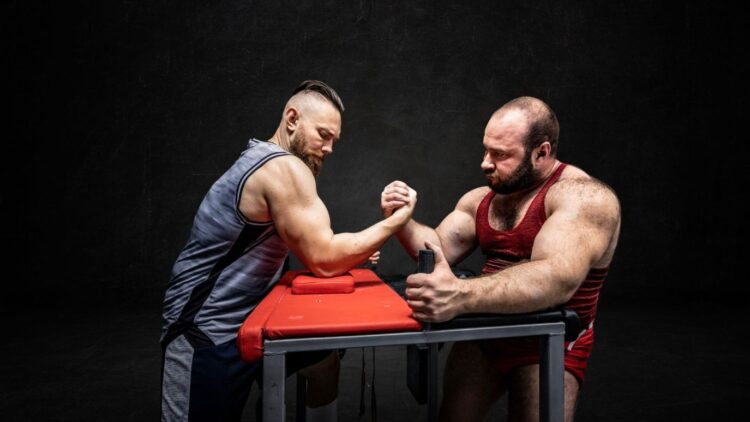
OBJECTIVE OF ARM WRESTLING: Overpower the opponent and forcefully pin their hand against the table.
NUMBER OF PLAYERS: 2 players
MATERIALS: Table, elbow pads, touch pads, hand grips, hand strap
TYPE OF GAME: Sport
AUDIENCE: All ages
OVERVIEW OF ARM WRESTLING
Arm wrestling is a sport that pits two competitors against each other in an all-out competition of brute arm strength. Traditionally a recreational game played among friends of all ages, arm wrestling has always been a casual way of determining who was the stronger person. Over the years, this deceptively simple game has transformed into a surprisingly popular competitive sport that hosts competitions with prize money reaching $250,000!
Historically, modern arm wrestling appears to have originated from the Japanese as far back as 700 AD! But the sport’s popularity peaked during Japan’s Edo Period between 1603 and 1867. In the United States, arm wrestling may have been widely influenced by Native American tribes who practiced a form of arm wrestling in which both competitors wrestled without a table.
Arm wrestling became an organized competitive sport in 1950 with the formation of the World Wrist Wrestling League. Since then, organizations such as the World Arm wrestling Federation (WAF) have formed, hosting competitive international events. It wasn’t until the 2010 formation of the World Arm wrestling League (WAL), however, that the sport’s popularity truly took off. Much of this recognition came as a result of social media virality, with top competitors, such as Canadian Devon Larratt, amassing over 500,000 followers on numerous social media platforms.
SETUP
EQUIPMENT
Considering the extreme simplicity of arm wrestling, no equipment is necessary to play other than a solid surface (generally a table). However, competitive arm wrestling utilizes a few key pieces of equipment to make the game more comfortable and technical:
- Table: While any solid surface should work, a table is generally recommended for competitors to rest their elbows on. This table should be of a height that enables both wrestlers to lean slightly over the table. For standing competitions, this table should be 40 inches from the floor to the top of the table surface (28 inches for seated).
- Elbow Pads: These pads provide cushion to each competitor’s elbow.
- Touch Pads: These pads are usually placed on the sides of the table and are the target that each competitor must pin their opponent’s wrist or hand against in order to win.
- Hand Grips: Usually present in the form of a peg on the edges of the table, these grips are where each competitor places their free hand.
- Hand Strap: Although rare in most competitions, a hand strap essentially ties both competitors’ wrestling hands together to avoid slippage or separation during the match.
TYPES OF EVENTS

Arm wrestling competitions can either be for right-handed competitors or left-handed competitors. However, due to simple demographics, many more people compete in right-handed tournaments.
Some arm wrestlers compete in both types of tournaments, with some very successful competitors winning as many left-handed competitions as they do right-handed ones.
Similar to other physical combat sports, weight classes are also used to ensure fair competition.
In men’s pro leagues, the weight classes are divided into 4 groups:
- 165 pounds and below
- 166 to 195 pounds
- 196 to 225 pounds
- Above 225 pounds
The men’s amateur leagues are divided into only 3 weight classes:
- 175 pounds and below
- 176 to 215 pounds
- Above 215 pounds
The women’s pro leagues are divided into the following weight classes:
- 135 pounds and below
- 136 to 155 pounds
- 156 to 175 pounds
- Above 175 pounds
GAMEPLAY
An arm wrestling match begins with both competitors interlocking thumbs as the referee ensures both sides have a fair grip. Once the referee determines a proper starting position is attained, the match immediately starts upon the word “go”.
Both competitors then attempt to slam the opponent’s hand onto the nearby touchpad. Basic biomechanics highlight the importance of a good start—getting even the slightest advantage at the beginning of the match allows the wrestler to use gravity to their advantage and further increase their leverage. Because of this, many matches can end within a split second if a wrestler cannot match their opponent’s explosive starting press.
An arm wrestling round continues until one competitor pins their opponent’s arm against the touchpad or commits a foul. In many cases, evenly matched wrestlers will find themselves in a grueling stalemate for most of the match, resulting in a battle of endurance that can last more than five minutes in extreme cases!
Check out this round in the WAL that lasted nearly 7 minutes!
Longest Armwrestling Round In WAL History
SCORING
Most arm wrestling competitions feature a best-of-three format. Whichever competitor wins two rounds is the winner of the match.
At lower levels of competition (or early tournament rounds), single rounds (or “pulls”) are often used to determine which competitor advances.
At high levels of competition, some tournaments feature a “super match”. These highly anticipated events pit two top-tier arm wrestlers against each other in a match that requires one wrestler to win between four and six total rounds.
RULES
Arm wrestling rules are in place to ensure no competitor is given an unfair advantage and minimal injuries occur. In most competitions, two fouls equal an automatic forfeit on behalf of the offender. These rules are enforced by two referees—one on each side of the table.
- The referee’s decision cannot be challenged.
- Competitors must begin a round with their shoulders squared with each other.
- The non-wrestling hand must remain on the hand grip peg for the entirety of the match.
- A competitor’s shoulder cannot cross the center line of the table during a round.
- Intentionally escaping the opponent’s grip to restart a round is a foul.
- Competitors must begin a round with at least one foot on the ground (this does not apply for the remainder of the match).
- Both competitors must keep their elbow in contact with the elbow pad for the entirety of a round.
- Applied force must be entirely sideways; force applied toward one’s own body can illegally pull the opponent toward the table.
- False starts result in a warning; two false starts result in a foul.
PROPER TECHNIQUE

Traditionally, arm wrestling matches are designed to be solely about arm/shoulder strength. Because of this, many recreational arm wrestlers will disallow any bodily movement other than from the wrestling arm.
That said, in competitive arm wrestling, the entire body can be utilized to help pin an opponent’s arm. This includes leaning and using one’s full body weight to increase leverage. Competitors will usually want to keep their upper arm centered and pulled closer to their body when possible.
Additionally, competitors utilize various techniques to give themselves more leverage during a match. Some of these include:
- Pressure: Pressures involve any technique that places the opponent in a disadvantageous position. These pressures can be applied to the opponent’s hand (such as bending their wrist back) or arm (slightly pulling the opponent’s hand toward your own side). Both of these pressure forms increase the user’s leverage while decreasing the leverage of the opponent.
- Hooking: Hooking is a technique that forces competitors to supinate their forearm and wrist. This results in both competitors’ palms facing their own bodies. Due to this supination, the biceps are heavily involved in this style of arm wrestling.
- Top Roll: Opposite of hooking, a top roll pronates the forearm of both competitors. This results in each competitor essentially making a palm-down fist pointed toward their opponent. This style of arm wrestling heavily engages the forearms and wrists.
- Pressing: A press involves a competitor fully positioning their shoulder behind their hand. Many times, this results in the competitor’s shoulders becoming perpendicular to their opponent’s shoulders. This generally makes it look like the wrestler is pushing their opponent’s arm toward the touchpad. This technique enables better use of the triceps and a person’s body weight.
WORLD’S TOP ARM WRESTLER
Canadian Devon Larratt is widely considered to be the most accomplished and recognizable arm wrestler in the world. Competing in the sport since 1999, Larratt was recognized as the world’s #1 arm wrestler in 2008 after beating the legendary John Brzenk 6–0. Since that day, Larratt has mostly retained his kingly status.
Larratt has been so dominant throughout his career, in fact, that his performance throughout 2021 compelled many of his competitors to tout that the 45-year-old arm wrestler was at a peak never before seen in the sport.
Thanks to Larratt’s expressive personality and willingness to collaborate with many popular fitness influencers, the sport of arm wrestling has grown massively popular online. While Larratt himself has nearly 700,000 subscribers on Youtube, many arm wrestling videos on the platform regularly reach millions of views, with multiple videos breaking the 100-million view mark. Even more impressive, a single arm wrestling video published in 2021 has since garnered 326 million views and counting! While Larratt cannot be credited entirely for the sport’s explosive popularity, it is safe to say he’s played a role in its booming success.
END OF GAME
The competitor who wins the majority of the predetermined matches by pinning their opponent’s hand against the touchpad is the winner of the arm wrestling match.
- 20+ FREE PRINTABLE BABY SHOWER GAMES - April 16, 2024
- 20+ College Party Games for the Best Night Ever! - April 2, 2024
- 31 BEST MOVIE DRINKING GAMES - March 14, 2024